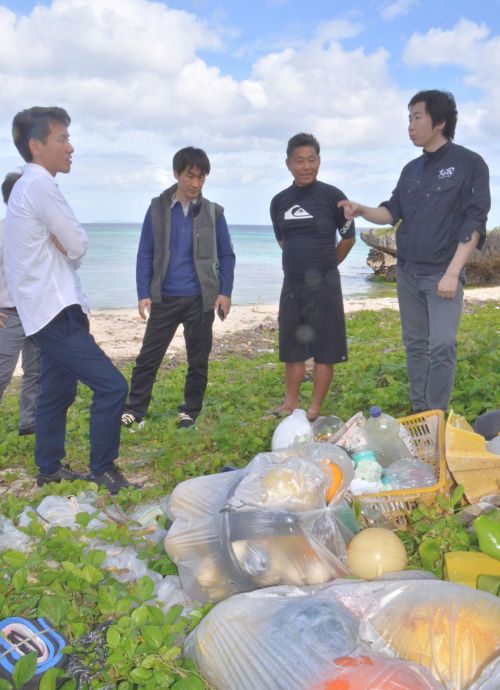Ryukyu University using drones, satellites and fixed cameras to clean up ocean garbage

Hiroshi Kudo (far right) and other project members conversing with community members who clean up the coastline around the garbage they collected that day. January 7 along the Motobu coast
January 8, 2020 Ryukyu Shimpo
A collaboration of research teams from organizations that include private businesses, the University of the Ryukyus, and Nagasaki University launched a project to survey ocean garbage coming ashore using satellites, drones, and fixed cameras on January 7.
The team first plans on getting an understanding of how trash is drifting ashore on Okinawa and Tsushima Island in Nagasaki, and is aiming to expanding the project to effectively predict and collect ocean-based garbage on a global level.
The project plans on accomplishing this by developing a diagnostic system that can detect where garbage will come ashore by analyzing images from satellites that capture images of the coastline.
The project will use drones and set fixed cameras along the coast to confirm the presence of the garbage, and will cross reference this against the simultaneous satellite imagery to be able to better use the satellites to track ocean garbage.
The project will be led by satellite part maker Amanogi (Tokyo) CEO Hiroshi Kudo, and they have enlisted the help of a drone-making company as well.
University of the Ryukyus engineering associate professor Donshik Kang will also be involved with the satellite imagery analysis and will be in charge of the on-site resources.
On the day of the project’s launch, the members visited the coastline in Motobu, and observed fishing nets, PET bottles, and Styrofoam containers scattered along the beach.
They also visited community members engaged in cleanup efforts as well as Motobu Town Hall and the Okinawa Prefectural Office.
Kudo said, “Since we have A.I. technology that can analyze satellite imagery, we thought that we needed to put it to use in some way.
If we can determine when and where this garbage is appearing on the earth’s surface, it would be a good use of that analysis.”
The project represents one of the initiatives of “Project Ikkaku,” a collaboration of the Nippon Foundation, the Japan Advanced Science and Technology Organization for education, human-resource and research (JASTO), and Leave a Nest, which has adopted the elimination of coastline garbage as one of their three main themes.
In addition to developing the garbage processing system, the project is also developing resources to recycle and develop consumer goods with recycled plastic, of which both initiatives will engage Okinawan businesses and research organizations.
(English translation by T&CT and Sam Grieb)
Previous Article:Hog Cholera raises concern in Okinawa where “pork is culture”
Next Article:Governor asks for MCAS Futenma closure, end to Henoko construction in New Year’s greeting
[Similar Articles]
- Nago’s GODAC reveals severe garbage problem in the deep sea, with a mannequin and sandals found at a depth of 6000 meters
- Okinawa and Hawaii to sign new memorandum on co-developing clean energy
- Okinawa’s higher education institutions do not apply for MOD national security research funds
- Academia, government enter seven-party partnership to preserve World Natural Heritage sites in Okinawa
- University of Tokyo faculty gathering photographs to create a 3D digital recreation of Shuri Castle to serve as “tourist attraction until the castle is rebuilt”
 Webcam(Kokusai Street)
Webcam(Kokusai Street)


